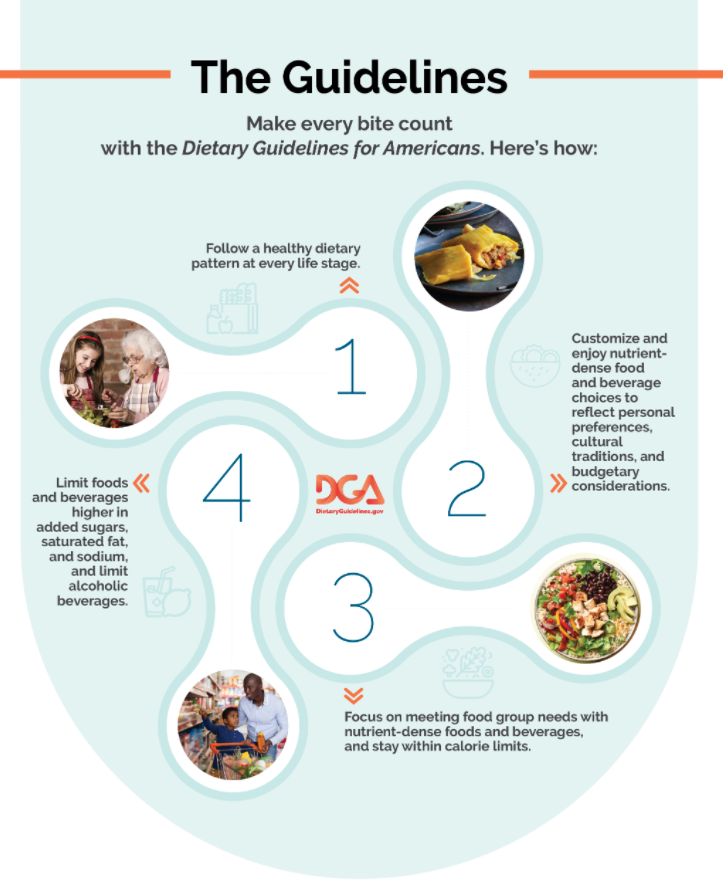By: Ashley Rosales, RDN

Nutrition and access to healthy food play a significant role in protecting the health of people across the life span, regardless of current health or nutritional status. The newly released 2020–2025 Dietary Guidelines for Americans provide recommendations on what Americans should eat and drink to promote health and help prevent chronic diseases. The Dietary Guidelines also serve as the basis for federal nutrition programs for the next five years.
Each edition of the Dietary Guidelines builds upon the previous edition, with updates made to dietary recommendations based on new and updated scientific nutrition evidence and research. Grounded in science and informed by the 2020 Dietary Guidelines Advisory Committee’s report, as well significant public and federal agency comments, the newly released 2020-2025 Dietary Guidelines for Americans were expanded to provide recommendations to address the needs of people at each life stage.
Dairy Council of California, a nutrition education organization, submitted public comments and shared a blog summary of the report's key highlights to keep its partners informed of the latest developments earlier this summer. With the release of the 2020-2025 Dietary Guidelines for Americans, there is an important call to action for health professionals, educators and policy makers to help the public “make every bite count” by educating and inspiring people to make informed food and beverage choices that are nutrition-dense. By educating and encouraging people to make healthier food and beverage choices, they can be supported to develop dietary patterns that lead to better health outcomes.

‘Make Every Bite Count’ With the Dietary Guidelines
Evidence continues to show that diet quality is low for many children and families in California and across the United States. Diet-related chronic diseases—such as cardiovascular disease, type 2 diabetes, obesity and some types of cancer—are prevalent among Americans and pose a major public health problem. Today, more than half of all American adults have one or more diet-related chronic diseases.
Every American, regardless of health status, can benefit by shifting eating habits to include healthier, nutrient-dense food and beverage choices. Nutrition science also shows it is never too late to start and maintain a healthy dietary pattern, which can yield health benefits in the short term and cumulatively over years. The Dietary Guidelines encourage Americans to “make every bite count” by following four overarching guidelines:
Almost all of the recommendations from the DGAC were adopted in the 2020–2025 Dietary Guidelines, with some notable exclusions. Due to lack of a “preponderance of evidence,” the DGAC recommendations to reduce the limits for added sugars and alcohol were not adopted; instead, recommendations were carried forward from the previous edition of the Dietary Guidelines: less than 10% of calories per day from added sugars for Americans aged 2 years and older and no more than one alcoholic beverage per day for women and no more than two alcoholic beverages per day for men.
Dietary Patterns and Diet Quality
While dietary recommendations have remained relatively consistent, the science they are founded on has evolved to focus on the importance of a healthy dietary pattern over time. The 2020-2025 Dietary Guidelines for Americans demonstrate this evolution, emphasizing the importance of an overall healthy dietary pattern rather than focusing on individual nutrients, foods or food groups in isolation. Translated, this means that more emphasis should be placed on the quality of foods and beverages you consume over time—such as over the course of a day or week—rather than any specific meal or single eating occasion. Eating patterns over time may be a better predictor of overall health status and disease risk than individual foods or nutrients because people consume food and beverages in combination to create a dietary pattern.
Healthy eating patterns are meant to provide a template for people to follow, offering flexibility to customize food choices to individual preferences, cultures and budgets. Dietary patterns that are associated with beneficial health outcomes include a higher intake of whole and minimally processed foods such as vegetables, fruits, legumes, whole grains, low-fat or non-fat dairy, lean meat, seafood, nuts and unsaturated vegetable oils, as well as lower consumption of processed meats, sugar-sweetened foods and drinks and refined grains. Focusing on a variety of nutrient-dense foods, while being mindful of portion sizes, should be the foundation of any eating pattern.
New Guidelines for Life Stages
Healthy eating is important across the life span, as acknowledged in this edition of the Dietary Guidelines by providing tailored recommendations to address five key life stages: infancy and toddlerhood, childhood and adolescence, adulthood, pregnancy and lactation, and older adulthood. This is the first time the Dietary Guidelines include recommendations for healthy eating patterns for infants and toddlers ages birth to 24 months.
For the first 6 months of life, the Dietary Guidelines recommend exclusively feeding infants human milk. Infants should also be provided with supplemental vitamin D beginning soon after birth. At about 6 months, infants should be introduced to nutrient-dense complementary foods, including potentially allergenic foods such as eggs, peanuts and soy products. Nutrient-rich dairy foods, including yogurt and cheese, are recommended for children under the age of 2, who are at a crucial period of growth and development. From 12 months through older adulthood, following a healthy dietary pattern across the lifespan will meet nutrient needs, help achieve a healthy body weight and reduce the risk for chronic disease.
Dairy’s Role in a Healthy Eating Pattern
The Dietary Guidelines reinforce the important role dairy foods like milk, cheese and yogurt play in eating patterns across the life span and the unique package of nutrients they contribute in the American diet, nutrients that would otherwise be underconsumed.
The Dietary Guidelines continue to recommend three servings of dairy in the Healthy U.S.-Style Eating Pattern and Healthy Vegetarian Eating Pattern, in keeping with past guidelines. Additionally, milk, yogurt and cheese are included in the first-ever healthy eating patterns recommended for infants and toddlers. This edition of the Dietary Guidelines also reaffirm dairy’s role as a source of three of the four nutrients of public health concern, including potassium, calcium and vitamin D, as well as iodine for pregnant women. Evidence continues to show that dairy foods like milk, yogurt and cheese offer a unique package of nutrients that work together to provide multiple health benefits, including optimal growth and development in children and reduced risk of developing chronic diseases such as type 2 diabetes and heart disease. The wide variety of available milk and dairy foods provides many options to meet personal needs, tastes and preferences.
Nutrition greatly impacts the health and well-being of people across their life span and influences many aspects of the lives of children and their families. Supporting access to nutrition education and nutrient-dense foods, including milk and dairy, will be critical to ensuring children are supported to grow healthfully and reach their full potential. The 2020–2025 Dietary Guidelines for Americans serve as a catalyst to spark collaborative action, nutrition policy and educational efforts, which can increase access to healthful foods and beverages and support adoption of healthy eating patterns for all ages and in all places where people live, learn, work, play and gather.
Dairy Council of California believes that collaboration is vital to prioritizing children’s health and building healthier communities. With this understanding, Dairy Council of California launched the Let’s Eat Healthy movement to empower stakeholders to champion community health through nutrition, including teaching and inspiring communities to “make every bite count” and finding solutions to make nutritious foods like milk and dairy foods accessible and affordable to all.
We invite stakeholders of the nutrition and health community to come together, join the movement and collectively enable change that is far greater and more impactful than what any single organization can do on its own. Learn more at HealthyEating.org/Join.

Ashley Rosales, RDN
Ashley Rosales, RDN
Ashley, Nutrition Science Officer, is a practicing registered dietitian nutritionist with more than a decade of experience.
The Dietary Guidelines for Americans serve as a catalyst to spark collaborative action, nutrition policy and educational efforts.

Trends is developed by Dairy Council to track trends impacting nutrition research + education, policy, consumer behavior, food innovation and more.

Subscribe to our blog to stay up to date on the latest news, products, and more.